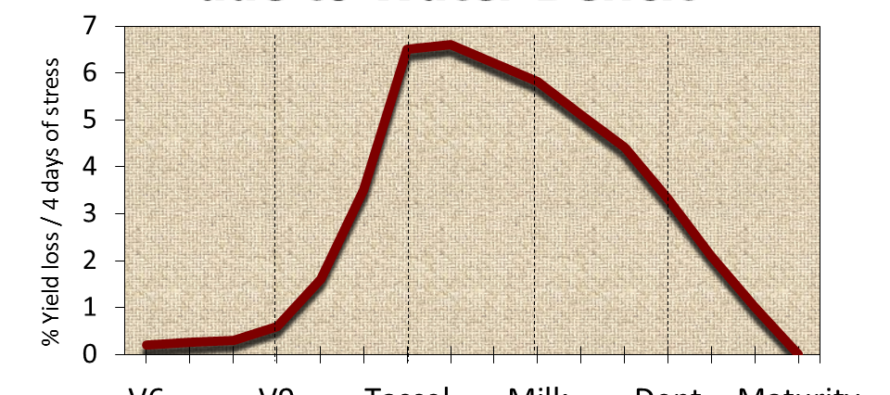When Should I Start Irrigating My Corn?

 The first week or two we go without rain and temperatures climb well into the 80’s, we are likely to see corn leaves start rolling. This scenario usually generates a lot more anxiety than necessary because wilting is usually associated with drought stress and not something we are very accustomed to. These conditions prompt much conversation about the proper time to initiate irrigation for corn. The simple answer is that irrigation should commence whenever soil moisture becomes limiting. However, we need to do more than see leaf wilting in order to accurately assess soil moisture. We should evaluate soil moisture availability using anything from simple methods to sophisticated soil moisture sensors to determine whether the crop actually needs more moisture and will respond in a manner that will ultimately enhance crop productivity. Corn leaf wilting during early vegetative stages commonly occurs because of a dramatic transition from cool spring to warm summertime weather, particularly when wet soils limit root depth during early vegetative stages. Thus, poor root depth is often the primary causal factor, and unnecessary irrigation will continue to restrict its development.
The first week or two we go without rain and temperatures climb well into the 80’s, we are likely to see corn leaves start rolling. This scenario usually generates a lot more anxiety than necessary because wilting is usually associated with drought stress and not something we are very accustomed to. These conditions prompt much conversation about the proper time to initiate irrigation for corn. The simple answer is that irrigation should commence whenever soil moisture becomes limiting. However, we need to do more than see leaf wilting in order to accurately assess soil moisture. We should evaluate soil moisture availability using anything from simple methods to sophisticated soil moisture sensors to determine whether the crop actually needs more moisture and will respond in a manner that will ultimately enhance crop productivity. Corn leaf wilting during early vegetative stages commonly occurs because of a dramatic transition from cool spring to warm summertime weather, particularly when wet soils limit root depth during early vegetative stages. Thus, poor root depth is often the primary causal factor, and unnecessary irrigation will continue to restrict its development.
 Since corn’s water demand and sensitivity to stress increases with plant size during vegetative stages (from emergence until tassel), plant growth stage plays a very important role, but there is not a definitive growth stage when irrigation should commence. Although corn at early vegetative stages is quite prone to wilt, it is however very tolerant of water deficit, particularly prior to V9. Thus, there is low justification to expect yield loss resulting from water deficiency during early vegetative stages, especially when we have plentiful moisture in the soil profile. We can discuss ad-nauseam when ear size determination begins, but the first and only corn yield component determined prior to tassel is the number of kernel rows per ear. If early season drought stress limits corn yield potential during mid-vegetative stages, you would see considerably fewer kernel rows per ear on dryland corn compared to irrigated corn grown in otherwise similar culture – and this rarely, if ever occurs in Mississippi. Conversely, overabundant pre-tassel rainfall (or excessive irrigation) definitely does reduce corn yield potential when we get too much of a good thing, like we saw last year and 2009. Also, keep in mind that the traditionally highest irrigated corn yields in the world are produced in areas with annual rainfall about three times less than ours. Thus, corn is better suited to a lot drier conditions than what we are accustomed to. In fact, a former world record corn yield producer from the Corn Belt emphasized his yields would suffer if seasonal rainfall exceeded 30 inches. So we must acknowledge there are negative effects on row crops associated with overabundant moisture. After all, we commonly grow our row crops on raised beds to help relieve issues with overabundant moisture.
Since corn’s water demand and sensitivity to stress increases with plant size during vegetative stages (from emergence until tassel), plant growth stage plays a very important role, but there is not a definitive growth stage when irrigation should commence. Although corn at early vegetative stages is quite prone to wilt, it is however very tolerant of water deficit, particularly prior to V9. Thus, there is low justification to expect yield loss resulting from water deficiency during early vegetative stages, especially when we have plentiful moisture in the soil profile. We can discuss ad-nauseam when ear size determination begins, but the first and only corn yield component determined prior to tassel is the number of kernel rows per ear. If early season drought stress limits corn yield potential during mid-vegetative stages, you would see considerably fewer kernel rows per ear on dryland corn compared to irrigated corn grown in otherwise similar culture – and this rarely, if ever occurs in Mississippi. Conversely, overabundant pre-tassel rainfall (or excessive irrigation) definitely does reduce corn yield potential when we get too much of a good thing, like we saw last year and 2009. Also, keep in mind that the traditionally highest irrigated corn yields in the world are produced in areas with annual rainfall about three times less than ours. Thus, corn is better suited to a lot drier conditions than what we are accustomed to. In fact, a former world record corn yield producer from the Corn Belt emphasized his yields would suffer if seasonal rainfall exceeded 30 inches. So we must acknowledge there are negative effects on row crops associated with overabundant moisture. After all, we commonly grow our row crops on raised beds to help relieve issues with overabundant moisture.




Let me tell You a sad story ! There are no comments yet, but You can be first one to comment this article.
Write a comment